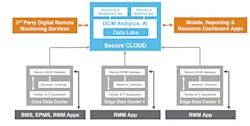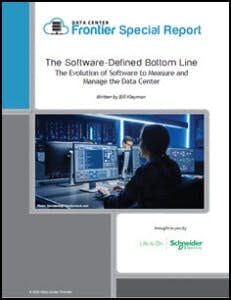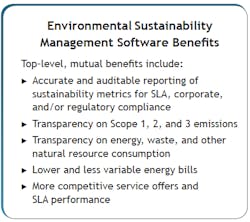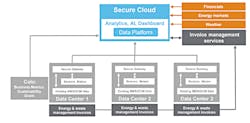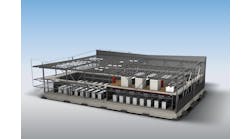The Software-Defined Bottom Line and the Data Center Value Equation
We continue our article series on the evolution of software to measure and manage the data center. Last week looked at the solutions and systems managing some of the most critical infrastructures in the world. This week, we’ll take a deeper look at the data center value equation and some key DCIM attributes.
Get the full report
First, let’s look at the data center value equation and understand how it has evolved. Before 2000 and before the more extensive deployment of Internet companies, the data center was seen as a simple business function, meaning it was seen as a tool and cost-center for many businesses. For many, the data center cost equation could be summarized like this:
Data Center Value = (Business Efficiency + Workforce Effectiveness + Market Outcome)
Of course, there are other variables in this. However, it was seen as a linear approach to managing, deploying, and operating data centers. It was a very mechanical approach where these systems were seen as necessary, but not necessarily, absolutely critical solutions.
Both data centers and business leaders will agree that their infrastructure is far more critical than just a few years ago. Furthermore, the level of persistent connectivity from remote users and remote business operations that we saw over the past year alone was unprecedented.
This is a big reason why the new value equation of digital infrastructure is here to stay:
Data Center Value = (Business Efficiency + Workforce Productivity) + Digital Innovation
The new variable here is ‘Digital Innovation.’ Beyond the marketing terminology, innovation in the digital infrastructure and data center space directly translates to surviving market and industry fluctuation, much like what we saw in 2020.
Let’s focus on digital innovation and how it will impact DCIM solutions. A significant modernization effort sees data center administrators moving away from legacy DCIM solutions and looking at the future of data center operations and management. As we touched on the five key DCIM attributes to consider in our previous article, let’s look at a few.
Next-generation DCIM typically installs as a simple gateway app on an existing server (physical or virtual). This avoids the often-lengthy security and validation reviews that can take weeks or months.
Uses cloud technologies for ease of implementation, scalability, analytics, and maintenance
By hosting the DCIM server in the cloud, deployment is more straightforward and faster by eliminating the need to procure a new server for every site. Next-generation DCIM typically installs as a simple gateway app on an existing server (physical or virtual). This avoids the often-lengthy security and validation reviews that can take weeks or months. Since each site would have required a DCIM server, this time savings can be significant when there are dozens or hundreds of small remote sites. This also makes the tool highly scalable in that it can handle an unlimited number of monitored devices across any number of sites.
Connects to a data lake that enables insights and event prediction with AI
The cloud-based architecture of next-generation DCIM also allows vendors to offer a data lake or a secure repository of massive amounts of anonymized device data. Big data analytics and machine learning algorithms can be developed and trained on this data to yield insights and make predictions that improve reliability, improve efficiency, and/or reduce operating expenses. Early examples of “big data” analytics and artificial intelligence applied to data center physical infrastructure include:
- Predicting when UPS batteries will fail allows for early planning and budgeting for service replacements
- Real-time optimization of cooling system controls based on changing climate and load conditions reduces operating expenses
- UPS health scorecard sorting the inventory of UPSs based on a determination of the device’s age and health — simplifies management by first focusing the user on what needs attention most. While this functionality is still in its infancy (at the time of this writing), data center and hybrid IT owners and operators considering DCIM solutions today can put themselves on the right future path by adopting a modern cloud-based DCIM architecture that includes a data lake.
This next consideration is critical. Integration with other critical systems has been a significant priority for data center leaders aiming to innovate how they manage their data centers.
With this attribute, end-users, trusted service partners, and vendors can all access the same data at the same time from any browser or mobile device. Open APIs enable DCIM data to be shared with any trusted vendor or partner. By being browser-based and encrypted, the need for a VPN and unique login credentials for every single site is eliminated. This gives real-time visibility to all assets and sites from one login. These attributes serve to mitigate the challenge of having many unmanned sites. For example, mobile access could help remote IT staff guide untrained, on-site personnel to troubleshoot and resolve issues without dispatching service. And integration into your MSPs RMM tool means that they can now manage and service your physical infrastructure equipment for you, just as they might be doing for your IT applications.
Environmental management, sustainability, and integration with DCIM
Environmental sustainability management software is an enterprise-level data collection, analytics, and visualization platform at a fundamental level. The ultimate aim of this software platform is to help:
- Minimize energy and other natural resource consumption
- Track and report environmental sustainability metrics
It supports data-driven decision-making and drives actions by collecting and reporting enterprise-level, consolidated resource information. This software benefits both the provider and its tenants when well-implemented and maintained.
Fundamentally, these benefits are enabled by the following essential functions of the software platform:
- Capturing relevant data
- Combining, harmonizing, and validating data
- Analyzing data
- Providing a sound basis for strategic decision-making, action, and reporting
The image below shows a high-level, simplified architectural diagram of an environmental sustainability management software platform to give a sense of how the system works. Further, it shows how this solution directly integrates with DCIM systems. The arrows represent data flow. Users, in this example, would connect to the cloud to view dashboards and interact with the software platform.
How the software-defined bottom line impacts the data center value equation
In general, software-defined solutions aim to abstract physical management and place it into the software layer. This translates to the ability to manage practically every aspect of data center operations in the data center world. This is a significant part of the digital innovation piece of the modern data center value equation.
Modern data center management solutions go far beyond traditional data center management requirements with improved visibility, data-driven tools, and more straightforward deployment strategies.
To support modern business requirements, data center operators will be asked to expand their scope of reporting by using intelligent software and data center management solutions. With these solutions, multi-skilled operators make better decisions with more data. Ultimately, this is how you become more valuable to the data center and the business.
Download the entire paper, “The Software Defined Bottom Line,” courtesy of Schneider Electric, to learn more. In our next article, we’ll look at how these modern DCIM tools are already making an impact in the data center and hyperscale space. Catch up on the previous articles here and here.

